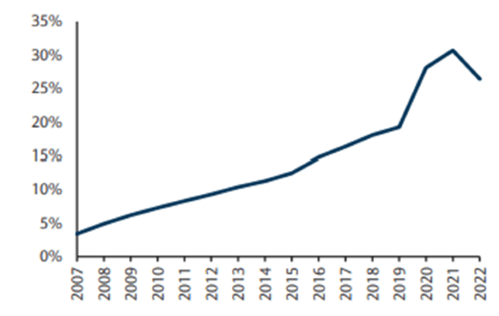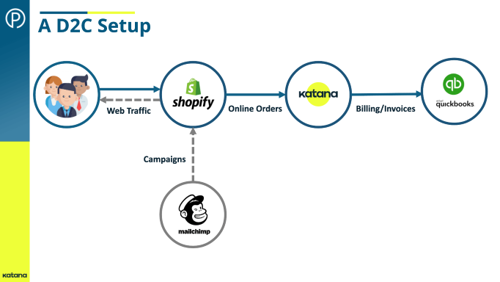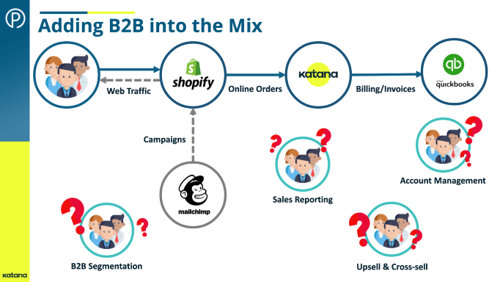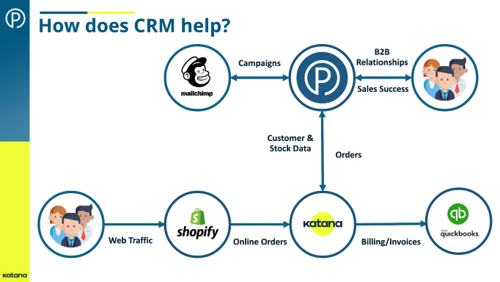
Unlocking your B2B Potential
 Thinking about selling B2B, a mixture of B2B and D2C, or looking to grow B2B sales through wholesale and distribution channels? Learn how you can stay ahead of current trends in the B2B space and get actionable advice on how unlock your B2B potential.
Thinking about selling B2B, a mixture of B2B and D2C, or looking to grow B2B sales through wholesale and distribution channels? Learn how you can stay ahead of current trends in the B2B space and get actionable advice on how unlock your B2B potential.
Current trends in the B2B space
Trend #1: D2C Brands Adopting B2B
Direct to consumer (D2C) brands are adopting B2B as a route to expansion. During the pandemic, there was a major shift in B2B companies adopting a D2C model. Take a simple example like coffee suppliers selling to coffee shops. With tight lockdowns and restrictions in place for months at a time, coffee shops were forced to temporarily close. Coffee suppliers would have to think smart, changing their strategy to targeting and selling their coffee directly to loyal customers who would normally buy and enjoy it from the coffee shops. By selling it straight to the end consumer via a D2C website, customers could still brew their favourite coffee in the luxury of their own home - and coffee suppliers didn’t lose out.
Despite this acclimatisation for many businesses, a report conducted by Barclays, using retail sales index information in the UK, stated that 2022 was the first year where the percentage of retail sales that were made online actually fell. Since 2007 and the boom of online retail - even through recessions - there has always been year on year growth in products sold online. But with COVID restrictions now largely a thing of the past, businesses have gradually returned to selling both on and offline. For the first time ever, the trend has gone in the opposite direction, indicating that increasing your customer reach isn’t just about selling online. If you’re selling products business to business, you’ll likely have customers who want to buy over the phone or via email as well as through your website.


Source: ONS, Retail Sales Index time series (DRSI) - internet sales as a percentage of total retail sales
Trend #2: No International Borders
The internationalisation of both D2C and B2B businesses is another factor to consider. Customers, whether they’re consumers/end-users or businesses who are buying the product, will buy from almost anywhere if the product meets their needs and the price is reasonable.
Barriers to international selling have also been lowered and the ease of selling overseas far outweighs the costs of shipping and fuel. The demanding nature of selling overseas has been relieved by the advent of 3PLs who take away the grief of stocking, shipping, and have ultimately reduced the cost of going international. It’s even possible to get 3PLs or other solutions for larger products that require installation.
Trend #3: Competition (and lots of it!)
An ever-present trend, competition is only accelerating. Competition is a huge factor in every route to market, but it seems that in modern B2B, there’s more competition than ever before. The big players (Amazon, eBay etc.) are, of course, here to stay. What’s also true is that lower barriers to entry means more competition from smaller sellers too. It’s much easier for smaller competitors to start up as there’s no need to invest in warehouses and distribution mechanisms, and they can start small, selling all over the world at a low price. With a higher rate of internationalisation, and a growing number of businesses adopting B2B and different sales channels, there’s growing competition in every market.
What can you do to stay ahead?
- Devise a clear B2B strategy - The number one failure that we see of D2C brands moving into B2B is thinking it’s all about the product. Successful businesses in B2B focus on customer relationships too.
- Differentiation is key - Why would anyone buy from you? What makes your product, service, or offering different? How are they going to make money reselling your product?
- Ultimately, what makes you desirable to a D2C customer is going to be different to that of your B2B audience. So, think about how you help them add value and be successful in this distribution chain.
- Use tech & automation - It’s a given that you need systems in place to ensure you can do all of the above repeatedly, at scale, and efficiently so that you’re not pricing yourself out of the market.
Tips for Growing a Wholesale Business
Step 1 - Product & Market Strategy: What, Why, Who?
- Who am I going to sell to and why would they care?
- Not just about taking your D2C product and selling to another retailer - ask yourself how you add value & how they add value (e.g., product bundling your cushions with their sofas)
- B2B offers more than that - key driver in B2B supply chains is value added
- Look for relationships that add value to you, your products, and your customers
Step 2 - Customer Success: Maximise CLTV
- Don’t just think of marketing and new customer acquisition - maximising CLTV is pivotal to success in B2B
- How are you going to look after your customers?
- How are you going to keep them for as long as possible?
- How are you going to upsell them?
- Be successful with initial relationships before scaling up
Step 3 - Marketing for scale: Find & Engage
- Identify your ICP
- How are you going to find more of them?
- How are you going to engage them?
The essence of this plan? Get a strategy, prove that success on a small scale, make changes to your strategy where necessary, optimise your customer success plan, then look to scale. Successful B2B wholesale businesses don’t simply focus on acquiring new customers - they look to maximise and increase the lifetime value of each and every customer.


A Typical D2C Setup
If you focus predominantly on D2C sales, you’ll more than likely have a setup similar to this. Customers will come to you via your D2C website (hosted on something like Shopify) and purchase your products through there. You may have some kind of marketing tool in place (like Mailchimp) to try and remarket to those customers to get them to come back and repurchase, and orders placed on your site will go into your MRP (something like Katana), where you can then make the product, ship it out, and invoice through a system like Xero or QuickBooks.


Adding B2B into the Mix


What’s missing is a focus on upsell and cross-sell opportunities - retaining the customer for as long as possible. To build strong B2B relationships and to be successful in the world of B2B, you need a much closer relationship with your customers.


Ready to unlock your B2B potential? Take an integrated Free Trial of Prospect CRM today!
